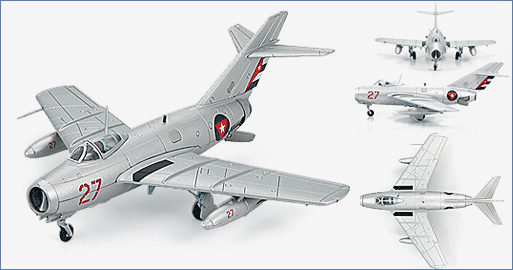Air Power Series>1:72 die-cast display model>MIG-15>HA2413
MIG-15 bis "27" Defensa Anti-Aérea Y Fuerza Aérea Revolucionaria Cuba

General Background
The MiG-15 (NATO name Fagot) was designed from information and technology gathered from captured WWII Germans. The main features of the Mig-15 were its simplicity and swept wings. The MiG-15bis was an improved single-seat fighter with better cannon, fuel capacity, avionics and a Klimov turbojet engine developed using an unlicensed Rolls-Royce Nene engine. All this was put in a strengthened airframe. The Allies were completely surprised when the Mig-15 arrived in Korea and quickly brought about the development of the F-86 Sabre.
The Aircraft
On January 1, 1959 the Fuerza Aérea Revolucionara (Revolutionary Air Force) was formed. After the Cuban Missile Crisis of 1962 the name was changed to Air Defense Anti Revolutionary Armed Forces (DAAFAR) in 1963. The role of the DAAFAR was to protect Cuban airspace, support the Cuban army and navy. New Years Day 1962 Cuba revealed about 60 fighter aircraft they had received from Russia. U.S. Intelligence estimated these 60 aircraft were comprised of MiG-15bis, MiG-17s and a small number of MiG-19s.
Specifications :
| Country of origin: | Russia |
| Manufacturer: | Mikoyan-Gurevich |
| Role: | fighter/interceptor |
| Crew: | 1 X pilot |
| Performance | |
| Engine: | 1 X 5,952 pound thrust Klimov VK-1 turbojet |
| Maximum Speed at Sea Level: | 668mph (1,075km/hr) |
| Ceiling: | 50,855ft. |
| Range: | 1,156miles (1860km) |
| Weight | |
| Emptyt: | 8,115lbs. (3,681kg) |
| Max Takeoff: | 13,327lbs. (6,045kg) |
| Dimensions | |
| Wing Span: | 33ft. 0.75in. (10,08m) |
| Length: | 35ft. 7.5in. (10,86m) |
| Height: | 12ft. 1.75in. (3,70m) |
| Armament: | 1 X 37-mm N-37 cannon |
| 2 X 23-mm NS-23 or NR-23 cannon | |
| Up to 1,100 pounds of mixed stores on under-wing hard-points |

